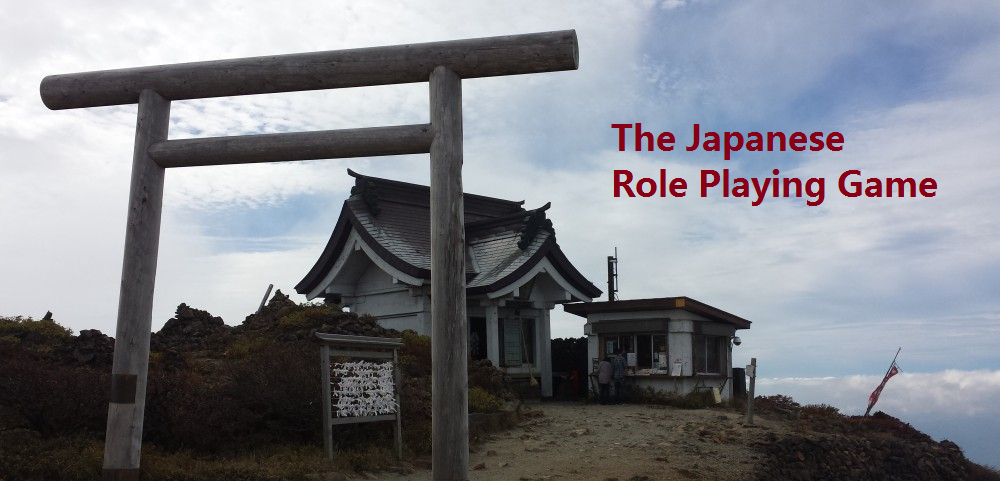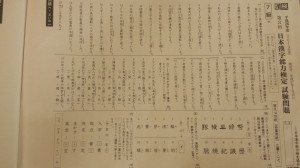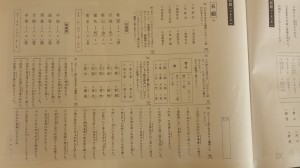漢字検定の受けること
JLPT. Psssssh.
Testing My Japanese
It was the spring of 2011. I had gone to Japan a year prior and was now in self-studying mode. While I might be one to extoll the virtues of learning on your own, I certainly didn’t make a great case for myself. This period was marked by a severe plateau, and a sense that I’d never be anything more than a novice Japanese speaker with a few words under my belt.
That vague feeling of failure and the prospect of a job teaching English in China pushed me towards learning Chinese and putting Japanese on the back burner. Thankfully, my experience in China (working in a language school, taking classes at that school, and having something of a rival) coupled with a solid background of Japanese helped my Chinese grow at a great rate and returned my fickle confidence in learning languages. My roommate brought his modded Wii to China too, and his solid supply of Japanese games made sure my language didn’t die completely (even if my reading turned into a mish-mash of Japanese and Chinese).
When I came back to the States in the spring of 2012, I felt encouraged to define my level in Japanese. After all, with all this weird study (video games and Chinese), how had my Japanese progressed?
Two friends at this time (let’s call them R and M) were very into Japanese. While many students and teachers had the JLPT (Japanese Language Proficiency Test, or: 日本語能力試験) on their minds, these guys looked a little further to a test called the Kanken (Kanji Kentei, or: 漢字能力検定). While the JLPT tests reading and listening (not speaking or writing, notably) and is aimed at foreigners learning Japanese, the Kanken tests reading Kanji and writing Kanji, and is aimed at Japanese people. Both tests lack any kind of speaking component, but it’s dangerous to think of any test as perfect.
But at that time, I looked at the imperfections of those tests. The Kanken was ridiculous and stupid, testing Kanji I’d never need, and including obtuse things like stroke order and determining what “the one radical” is for a Kanji. The JLPT was bologna too. After all, if kids could pass the thing and not speak Japanese, as I’d seen, it clearly didn’t do a good job of testing.
Instead of these official routes, I started looking online for any manner of testing I could find. Little websites like this and this helped me see what I knew, though they produced nothing I could frame. Not to mention that testing myself ended up so haphazard that I never got a clear picture.
But I was satisfied. I was somewhere in the “intermediate / advanced” camp. I was past the basics in any case. I leaned back and accepted that I’d made some progress in the past few years.
Testing In Japan
Fast forward to 2013 and my move to Japan. Every foreigner who’d just come was trying to prove how much Japanese they knew, and taking the JLPT became as much a source of pride as it was a goal to move towards. When people asked why I wouldn’t take the JLPT, I scoffed like a hipster and said I was above those things. I would only take the test once I was fluent, and I wasn’t there yet, so any certification I’d get would be a lie anyways, right?
Then, what is “fluency”? Would there ever be an appropriate time to take the JLPT?
It didn’t help that the JLPT costs 5000 yen and a train ticket to the city. That was a little steep for me. Not that 5000 yen is particularly expensive, but that I didn’t want to spend all this money just to learn something I knew all along: that my Japanese is alright.
One day, the Japanese teacher at my school mentioned at the morning meeting that they’d be holding the Kanji Kentai at the school. In fact, every year they held it 2-3 times. She looked at me and asked if I’d like to take it. I smiled and said, “next time”.
Next time came, and she asked me again. This time I caved. After all, the Kanken was only 1500 at the level I wanted to take it. No train ride either; I’d just stay after school.
Signing up, I felt this new surge of motivation. “I should study,” I thought, for the first time in ages. Actually study. All the scoffing had prevented me from dedicating myself to some solid studying with a goal in mind. The goal is the important thing, and even 1500 yen on the line was enough to push me. I could see why others were saying the high cost of the JLPT motivated them. The train trip allowed for a little extra cramming too, they said. Suddenly, it made some sense.
An Aside: JLPT and Kanken Levels
Both the JLPT and Kanken are divided into levels, the JLPT from 1-5 (it used to be 1-4), and the Kanken from 1-10, where 1 is the highest in both cases. The Kanken actually has 12 separate levels, with 1 and 2 having “pre-“ levels.

This chart shows how many people took the test this time around and their pass-rate. The star above the six is because that was the level I took.
Of all the JLPT levels, only 2 and 1 have any sort of value in getting a job. Both denote a level of fluency, in theory. As a result, most people aim for JLPT level 2.
The Kanken levels are actually closely tied to the Japanese grades in reverse. So, if you know all the Kanji that a 1st grader will know, take the Level 10. All the Kanji a second grader will learn is covered in Level 9. And so on.
In general, the really dedicated kids in middle school go for levels 5, 4, and 3. High schoolers and adults might go for pre-2 or 2. Scholars and crazy people aim for pre-1 and 1. While few foreigners have passed level 1, some have, so it’s not impossible.
Kanji Kentei – Level 7
I decided to dive in and look at what level would be appropriate. Level 10 was too easy. These were kanji I knew like the back of my hand. Things like 一二三 and 日. If you pass the Kanken with a perfect score, you’ll get a special certificate denoting that. But the test only comes around a few times a year, so I didn’t want to waste my time on something I could do without effort. 9 was in the same camp. 8 was starting to get into my range. I was pretty sure I could pass 8 with only a little studying. Waste of time.
At Level 7, the Kanken looked like something I’d have to study for. Yes, I knew maybe two-thirds of the characters. But writing: I hadn’t done that in ages. Certainly not for all these. It would be a challenge.
I bought two books for the level, both official resources that everyone and their stapler were using. They listed out all the kanji that appear and had exercises modeled like the tests. Of course, as resources for Japanese people, they didn’t list out any definitions, neither in English nor Japanese.
In spite of buying the books with great intents, I barely used them until the week before the test. Classic procrastination. When I started to use them, I still had problems. “How do I use this?” I’d think to myself.
Then, the day of the test came. 4 pm. I drove back to the middle school from the elementary school and perched myself in a desk in the 1st year classroom. Students surrounded me on all sides, studying as well, helping me when they had the chance.
Then the test itself came. I wrote my name on the answer sheet, and started working through the questions. It starts with the reading and moves onto the writing. The reading I did moderately well in, and I had some self-assurance that I could pass this thing.
Then the writing questions came. All hope, down the drain. On one section, I managed to get right only 3 of the 20 questions. It was…pitiful. Another section required writing a word with the opposite meaning. Antonyms, I suppose. I didn’t pay attention to those problems in the booklet and I was rewarded thusly. Even more painful were the numerous kanji I “knew” but couldn’t write. I suppose this is the primary challenge for most people too.
A month or so later I got my results back and they were about as expected. I was about 20 points short of the passing grade (140/200). Still, I’d learned a lot, and after the test, I managed to learn to write many more kanji. There was value to the study, and even more value to the failure.
In the weeks following, I remembered the ultimate tool I’d used in the past: Asking others for tests at random. With this tool back in my arsenal, I decided to sign up for the next test. But this time, one level higher.
Kanji Kentei – Level 6
Where is the value in studying material you’d already known?
When the next round of Kanji Kentei came up, I was quick to sign up. This time, with level 7 being “too easy” (nevermind the fact that I failed it), I set my sights higher on level 6. After deciding, I bought the same type of book I used last time. Instead of studying only in the week before, I managed to give myself a little more time to work with.

In preparation for the test, I even took a random test with the students. I failed pretty badly. But that was days before the actual test, and a nice wake-up call.
Giving people my book and asking for help became a ritual. My staff rooms knew of my coming test and would give me quizzes occasionally. I focused on my problem areas: writing and synonyms / antonyms.
I definitely wasn’t perfect.
When the test rolled around, I was still nervous. This time, I managed to write answers for most of the test. Some answers still eluded me, but they were fewer this time around. I strode out of the test room with a smile on my face.
A month later: Pass! In a reversal from last time, I now had about 20 points above the passing grade. The Japanese teacher gave me a warm congratulations and the whole staff room applauded briefly.
It was a good moment, but, like I’m trying to portray in writing, a stepping stone. A minor moment of victory to help validate what I’m doing. Motivation to continue down this road. 未来へ進む刺激. The next day I bought a book for level 5.
My Recommendation: Take It
Well, depending on who you are.
- If you recognize that there is some purpose in learning to write Kanji, take it. I find spending time writing and learning Kanji give me a stronger foundation for the Kanji, but that’s just me.
- If you teach at a school in Japan, take it. I mean, all you have to do is say after another hour. Is that so bad?
- If you have some pocket change to spare, take it. Each level costs different amounts, with Level 1 costing the same as JLPT: 5000 yen.
- If you think you can pass the Level 3 or higher, definitely take it. Level 3 or higher requires a photo ID, and is the level that businesses in Japan start to really care about it.
- If you need some motivation to learn Kanji, take it. Because sometimes we all need some motivation.
In any case, if you do decide to take it, enjoy! It’s a fun road to travel down.











You were talking about the JLPT into partway through when you stopped and focused mostly on the Kanji Kentei. Did you take the JLPT and if so, how was it?
I’m in a similar boat where I think I should be able to pass the JLPT (I hope to at least level 2), assuming I do some studying just to make sure. However, I would have to fly pretty far (several hours by plane) just to go somewhere that I can take it. Also, since I am not looking for a job where I use Japanese I am not sure if there is any real purpose to it.
So technically, I’ve never taken the JLPT. 😛 I did proctor the JLPT 1, which meant I could see the whole test and listen to the listening portion. At that time, my level was much lower. The reading wasn’t too bad, but the listening went over my head entirely.
Whether or not you should take it: I’d say ‘no’. Especially if it’s that much of a journey. If you’re trying to apply for a Japanese company or a translation job…or you want to take the test and figure a fun trip to the city is a good excuse…then certainly, go right ahead. But it does sound like it doesn’t make much sense for you, unless you really want some motivation for your Japanese study. 🙂
Thanks for the confirmation on that, though eventually I may consider trying to use my Japanese skills as a career and at that point I guess I should take it. Hopefully it will be as easy as I think (:
Judging from your blog, you should be able to pass N1. 😛 If you can read books and understand most of what’s going on, you’re good. But study too, when the time comes. Like any Japanese test, the test closely reflects the official study materials. It can’t hurt for those questions like:
木村さんとは共通の趣味があるので、いつも会話が( )
1舞う 2弾む 3転がる 4跳ねる
Choosing the correct word can be hard sometimes. 😛 That’s my personal biggest weakness.
Thanks of the encouragement (: Hopefully I can keep studying so by the time I actually take the test I can get 100%.
For the question you gave, I am pretty sure the answer is ‘2’ because I’ve heard the phrase 会話がはずむ before. However if I hadn’t been experienced to that it would have been almost impossible to guess.
I actually selected that one from a sample test because I wasn’t sure of it when I looked at it. But you got it! 🙂 Guess that means you’re set. 😛
Yeah in all seriousness one question isn’t very statistically significant (: I’m torn on taking a full practice test because if I fail, I’ll be upset, and if I pass part of me will be happy, but at the same time think (why don’t I just go take the test for real). So I guess either way there is a disadvantage (:
Nice! Question: Is there a minimum score in each kanken section you need in order to pass the test? Or can it just be 70/80 percent of all questions even if you do miserably in some sections? (I’m looking at 6級)
Nope. As long as you get 70% (140/200), you’re set. Even if that meant you had two sections where you didn’t get a single one.
Why, is there some section you’re worried about?
Well, I just took some of the practice tests for 6級, and I did great on all the parts that asked about already-written kanji…when I had to come up with and write my own it was pretty rough, haha. But if it’s scored that way I should be fine.
That was actually one of my biggest problems originally. Like, I knew how to read 勇 any day of the week, but to write 勇, for whatever reason, was impossible when I took the 7級. I always have people test me when we have some free time to solve that problem. For instance, they would ask me to write 縮まる and I’d have to do it. Better the more random and unprompted it was.
Pingback: The Ultimate Test For Language Enthusiasts – Kanji Kentei | Japan Info
In Feb. 2021 I was able to pass the first level of Kanken